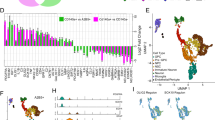Abstract
TMEFF1 is a novel transmembrane protein, containing two follisatin domains and an epidermal growth factor-like region. These structural domains suggest a role for TMEFF1 in growth factor signaling. TMEFF1 fused to enhanced green fluorescent protein revealed that TMEFF1 is expressed on the cell membrane. Northern analysis of normal human tissue showed that TMEFF1 is predominantly expressed in the brain. Study of cancer cell lines from different tissues including the brain, demonstrated moderate to low levels of TMEFF1 in most of these transformed cell lines. Furthermore, quantitative real-time RT–PCR analysis of 54 brain tumors showed that most of these tumors (96%) had lower levels of TMEFF1 expression than normal brain tissue. Interestingly, ectopic expression of TMEFF1 in brain cancer cells resulted in their growth inhibition. These data suggest that TMEFF1 may behave as a tumor suppressor gene in brain cancers.
This is a preview of subscription content, access via your institution
Access options
Subscribe to this journal
Receive 50 print issues and online access
$259.00 per year
only $5.18 per issue
Buy this article
- Purchase on Springer Link
- Instant access to full article PDF
Prices may be subject to local taxes which are calculated during checkout





Similar content being viewed by others
References
Eib DW, Holling TM, Zwijsen A, Dewulf N, de Groot E, van den Eijnden-van Raaij AJ, Huylebroeck D and Martens GJ . (2000). Mech. Dev., 97, 67–71.
Eib DW and Martens GJ . (1996). J. Neurochem., 67, 1047–1055.
Eib DW, Merkx GF, Martens GJ and Cremers FP . (1998). Cytogenet. Cell Genet., 81, 180–181.
Engler DA, Montelione GT and Niyogi SK . (1990). FEBS Lett., 271, 47–50.
Gery S, Sawyers CI, Agus DB, Said JW and Koeffler HP . (2002). Oncogene, 21, 4739–4746.
Glynne-Jones E, Harper ME, Seery LT, James R, Anglin I, Morgan HE, Taylor KM, Gee JM and, Nicholson RI . (2001). Int. J. Cancer, 94, 178–184.
Horie M, Mitsumoto Y, Kyushiki H, Kanemoto N, Watanabe A, Taniguehi Y, Nishino N, Okamoto T, Kondo M, Mori T, Noguchi K, Nakamura Y, Takahashi E and Tanigami A . (2000). Genomics, 67, 146–152.
Kupprion C, Motamed K and Sage EH . (1998). J. Biol. Chem., 273, 29635–29640.
Patel K . (1998). Int. J. Biochem. Cell Biol., 30, 1087–1093.
Patthy I and Nikolics K . (1993). Trends Neurosci., 16, 76–81.
Westermark B and Westermark M . (1995). Curr. Opin. Oncol., 7, 220–225.
Acknowledgements
The project was sponsored by the Department of the Army, award number DAMD17-02-1-0031. The US Army Medical Research Acquisition Activity, 820 Chandler St, Fort Detrick, MD 21702-5014 is the awarding and administering acquistion office. The content of the information does not necessarily reflect the position or policy of the government, and no official endorsement should be inferred. This work was supported in part by C and H Koeffler Research Fund. Horn Foundation and Parker Hughes Trust and a grant from the Maxine Dunitz Neurosurgical Institute, Cedars-Sinai Medical Center. HPK is a member of the Jonsson Comprehensive Cancer Center and holds the endowed Mark Goodson Chair of Oncology Research at Cedars-Sinai Medical Center/UCLA School of Medicine.
Author information
Authors and Affiliations
Corresponding author
Rights and permissions
About this article
Cite this article
Gery, S., Yin, D., Xie, D. et al. TMEFF1 and brain tumors. Oncogene 22, 2723–2727 (2003). https://doi.org/10.1038/sj.onc.1206351
Received:
Revised:
Accepted:
Published:
Issue Date:
DOI: https://doi.org/10.1038/sj.onc.1206351
Keywords
This article is cited by
-
A feature selection approach for identification of signature genes from SAGE data
BMC Bioinformatics (2007)



